2016 NISSAN ALTIMA instrument panel
[x] Cancel search: instrument panelPage 366 of 491
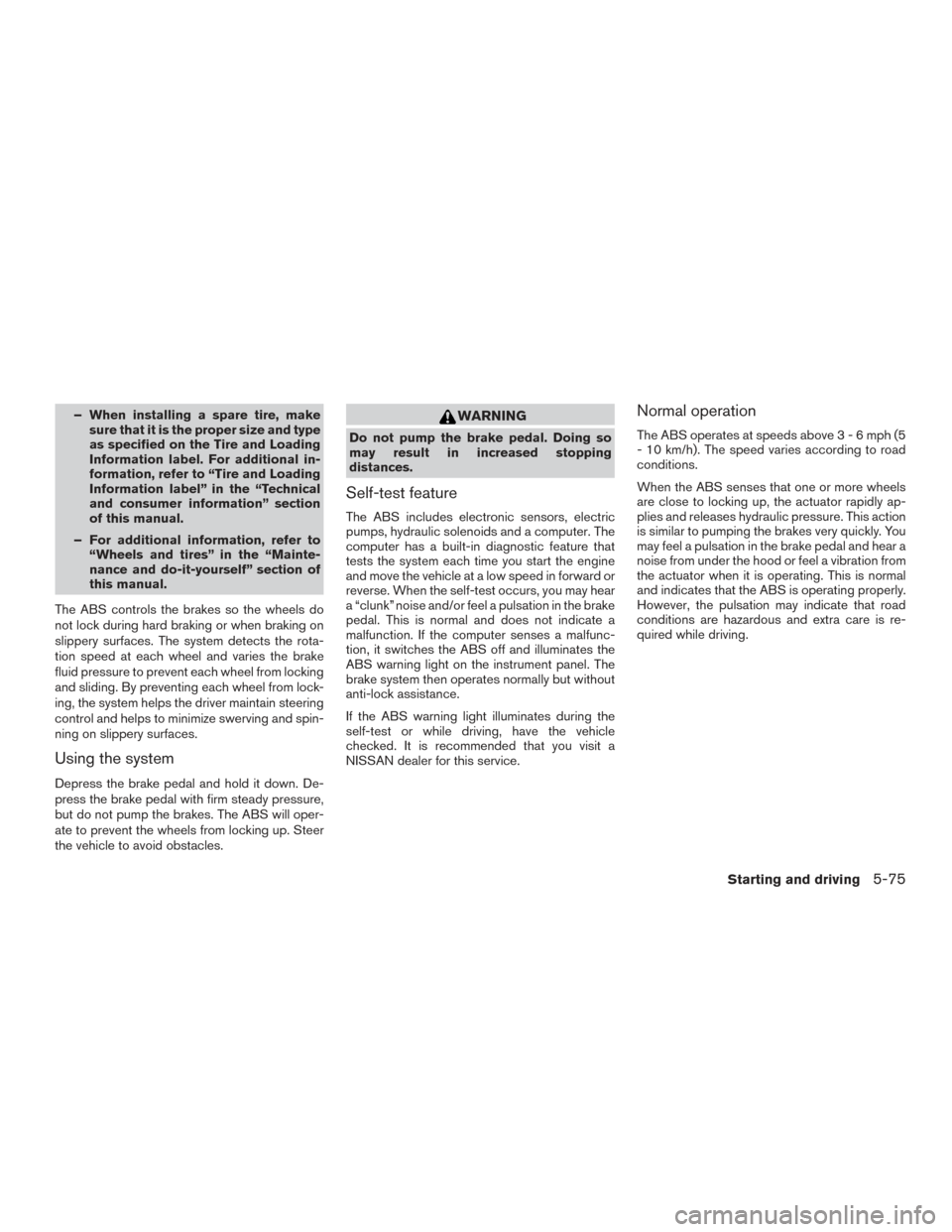
– When installing a spare tire, makesure that it is the proper size and type
as specified on the Tire and Loading
Information label. For additional in-
formation, refer to “Tire and Loading
Information label” in the “Technical
and consumer information” section
of this manual.
– For additional information, refer to “Wheels and tires” in the “Mainte-
nance and do-it-yourself” section of
this manual.
The ABS controls the brakes so the wheels do
not lock during hard braking or when braking on
slippery surfaces. The system detects the rota-
tion speed at each wheel and varies the brake
fluid pressure to prevent each wheel from locking
and sliding. By preventing each wheel from lock-
ing, the system helps the driver maintain steering
control and helps to minimize swerving and spin-
ning on slippery surfaces.
Using the system
Depress the brake pedal and hold it down. De-
press the brake pedal with firm steady pressure,
but do not pump the brakes. The ABS will oper-
ate to prevent the wheels from locking up. Steer
the vehicle to avoid obstacles.
WARNING
Do not pump the brake pedal. Doing so
may result in increased stopping
distances.
Self-test feature
The ABS includes electronic sensors, electric
pumps, hydraulic solenoids and a computer. The
computer has a built-in diagnostic feature that
tests the system each time you start the engine
and move the vehicle at a low speed in forward or
reverse. When the self-test occurs, you may hear
a “clunk” noise and/or feel a pulsation in the brake
pedal. This is normal and does not indicate a
malfunction. If the computer senses a malfunc-
tion, it switches the ABS off and illuminates the
ABS warning light on the instrument panel. The
brake system then operates normally but without
anti-lock assistance.
If the ABS warning light illuminates during the
self-test or while driving, have the vehicle
checked. It is recommended that you visit a
NISSAN dealer for this service.
Normal operation
The ABS operates at speeds above3-6mph(5
- 10 km/h). The speed varies according to road
conditions.
When the ABS senses that one or more wheels
are close to locking up, the actuator rapidly ap-
plies and releases hydraulic pressure. This action
is similar to pumping the brakes very quickly. You
may feel a pulsation in the brake pedal and hear a
noise from under the hood or feel a vibration from
the actuator when it is operating. This is normal
and indicates that the ABS is operating properly.
However, the pulsation may indicate that road
conditions are hazardous and extra care is re-
quired while driving.
Starting and driving5-75
Page 367 of 491
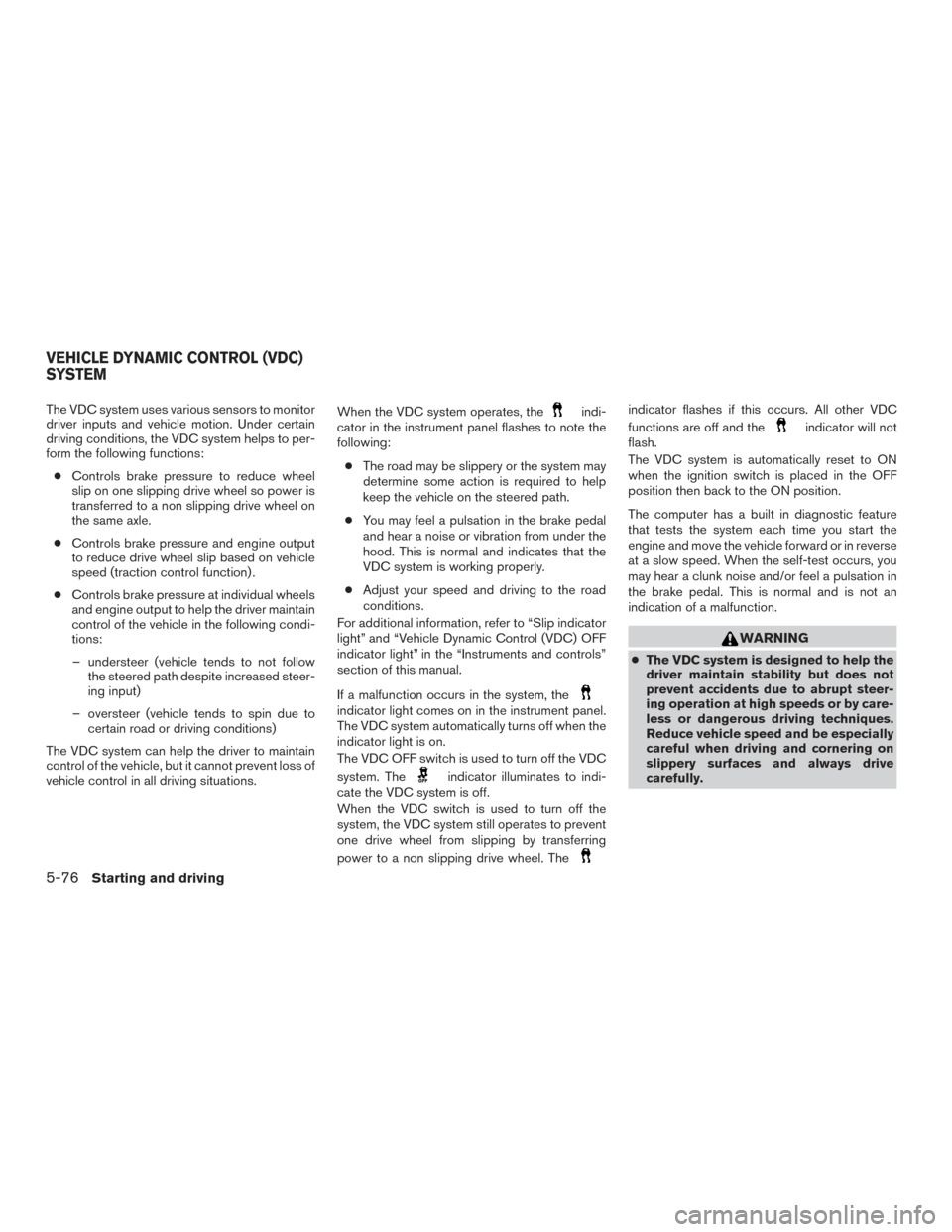
The VDC system uses various sensors to monitor
driver inputs and vehicle motion. Under certain
driving conditions, the VDC system helps to per-
form the following functions:● Controls brake pressure to reduce wheel
slip on one slipping drive wheel so power is
transferred to a non slipping drive wheel on
the same axle.
● Controls brake pressure and engine output
to reduce drive wheel slip based on vehicle
speed (traction control function) .
● Controls brake pressure at individual wheels
and engine output to help the driver maintain
control of the vehicle in the following condi-
tions:
– understeer (vehicle tends to not follow the steered path despite increased steer-
ing input)
– oversteer (vehicle tends to spin due to certain road or driving conditions)
The VDC system can help the driver to maintain
control of the vehicle, but it cannot prevent loss of
vehicle control in all driving situations. When the VDC system operates, theindi-
cator in the instrument panel flashes to note the
following:
● The road may be slippery or the system may
determine some action is required to help
keep the vehicle on the steered path.
● You may feel a pulsation in the brake pedal
and hear a noise or vibration from under the
hood. This is normal and indicates that the
VDC system is working properly.
● Adjust your speed and driving to the road
conditions.
For additional information, refer to “Slip indicator
light” and “Vehicle Dynamic Control (VDC) OFF
indicator light” in the “Instruments and controls”
section of this manual.
If a malfunction occurs in the system, the
indicator light comes on in the instrument panel.
The VDC system automatically turns off when the
indicator light is on.
The VDC OFF switch is used to turn off the VDC
system. The
indicator illuminates to indi-
cate the VDC system is off.
When the VDC switch is used to turn off the
system, the VDC system still operates to prevent
one drive wheel from slipping by transferring
power to a non slipping drive wheel. The
indicator flashes if this occurs. All other VDC
functions are off and the
indicator will not
flash.
The VDC system is automatically reset to ON
when the ignition switch is placed in the OFF
position then back to the ON position.
The computer has a built in diagnostic feature
that tests the system each time you start the
engine and move the vehicle forward or in reverse
at a slow speed. When the self-test occurs, you
may hear a clunk noise and/or feel a pulsation in
the brake pedal. This is normal and is not an
indication of a malfunction.
WARNING
● The VDC system is designed to help the
driver maintain stability but does not
prevent accidents due to abrupt steer-
ing operation at high speeds or by care-
less or dangerous driving techniques.
Reduce vehicle speed and be especially
careful when driving and cornering on
slippery surfaces and always drive
carefully.
VEHICLE DYNAMIC CONTROL (VDC)
SYSTEM
5-76Starting and driving
Page 468 of 491
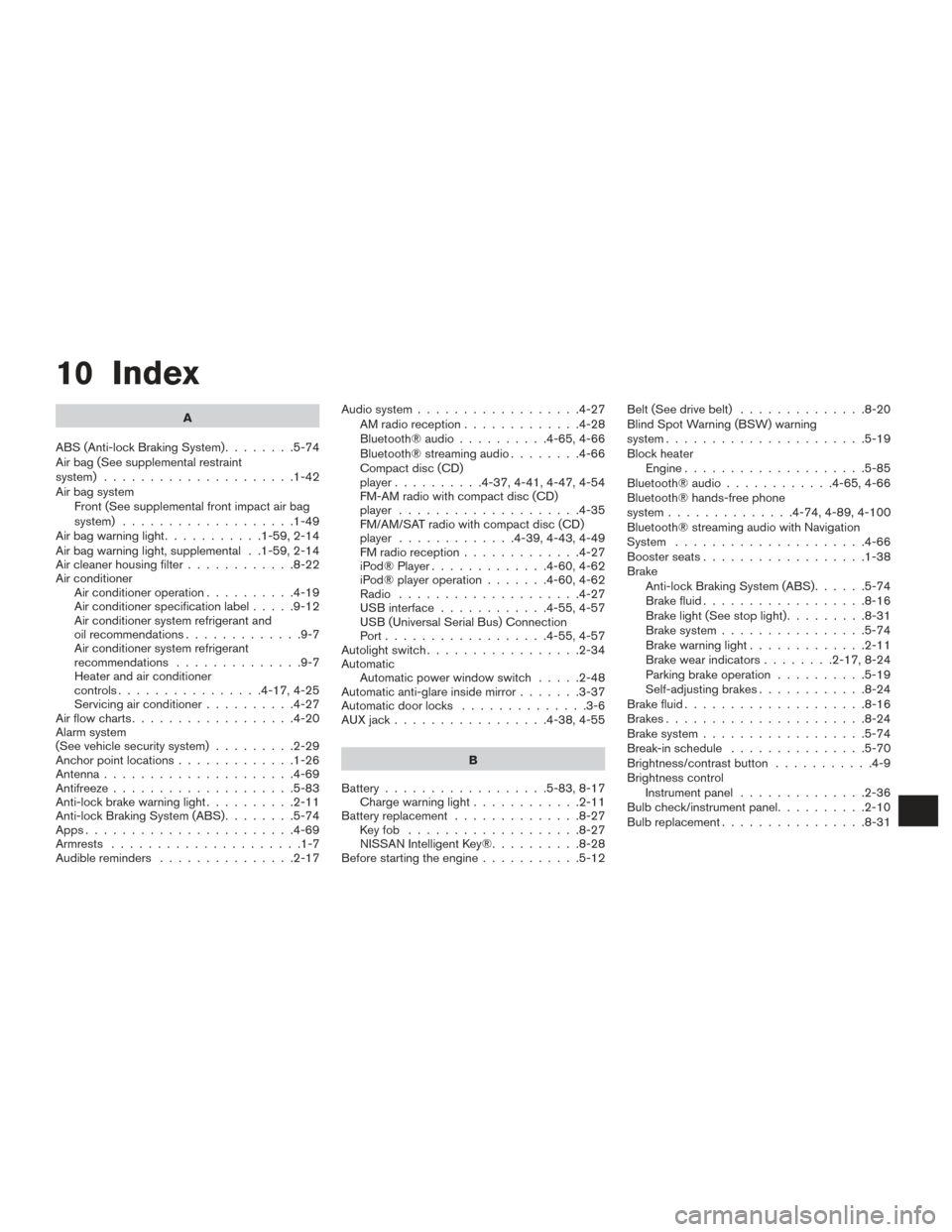
10 Index
A
ABS (Anti-lock Braking System) ........5-74
Air bag (See supplemental restraint
system) .....................1-42
Air bag system Front (See supplemental front impact air bag
system) ...................1-49
Airbagwarninglight...........1-59,2-14
Air bag warning light, supplemental . .1-59, 2-14
Air cleaner housing filter ............8-22
Air conditioner Air conditioner operation ..........4-19
Air conditioner specification label .....9-12
Air conditioner system refrigerant and
oil recommendations .............9-7
Air conditioner system refrigerant
recommendations ..............9-7
Heater and air conditioner
controls................4-17,4-25
Servicing air conditioner ..........4-27
Airflowcharts..................4-20
Alarm system
(See vehicle security system) .........2-29
Anchor point locations .............1-26
Antenna .....................4-69
Antifreeze ....................5-83
Anti-lock brake warning light ..........2-11
Anti-lock Braking System (ABS) ........5-74
Apps .......................4-69
Armrests .....................1-7
Audible reminders ...............2-17 Audio system
..................4-27
AMradioreception.............4-28
Bluetooth®audio..........4-65,4-66
Bluetooth® streaming audio ........4-66
Compact disc (CD)
player..........4-37,4-41,4-47,4-54
FM-AM radio with compact disc (CD)
player ....................4-35
FM/AM/SAT radio with compact disc (CD)
player .............4-39,4-43,4-49
FMradioreception.............4-27
iPod® Player .............4-60,4-62
iPod® player operation .......4-60,4-62
Radio ....................4-27
USB interface ............4-55,4-57
USB (Universal Serial Bus) Connection
Port..................4-55,4-57
Autolight switch .................2-34
Automatic Automatic power window switch .....2-48
Automatic anti-glare inside mirror .......3-37
Automatic door locks ..............3-6
AUXjack.................4-38,4-55
B
Battery ..................5-83,8-17
Chargewarninglight............2-11
Battery replacement ..............8-27
Keyfob ...................8-27
NISSAN Intelligent Key® ..........8-28
Before starting the engine ...........5-12 Belt (See drive belt)
..............8-20
Blind Spot Warning (BSW) warning
system......................5-19
Block heater Engine ....................5-85
Bluetooth® audio ............4-65,4-66
Bluetooth® hands-free phone
system..............4-74,4-89,4-100
Bluetooth® streaming audio with Navigation
System .....................4-66
Boosterseats..................1-38
Brake Anti-lock Braking System (ABS) ......5-74
Brake fluid ..................8-16
Brakelight(Seestoplight).........8-31
Brake system ................5-74
Brakewarninglight.............2-11
Brakewearindicators........2-17,8-24
Parking brake operation ..........5-19
Self-adjusting brakes ............8-24
Brake fluid ....................8-16
Brakes ......................8-24
Brake system ..................5-74
Break-inschedule ...............5-70
Brightness/contrast button ...........4-9
Brightness control Instrument panel ..............2-36
Bulb check/instrument panel ..........2-10
Bulbreplacement................8-31
Page 469 of 491
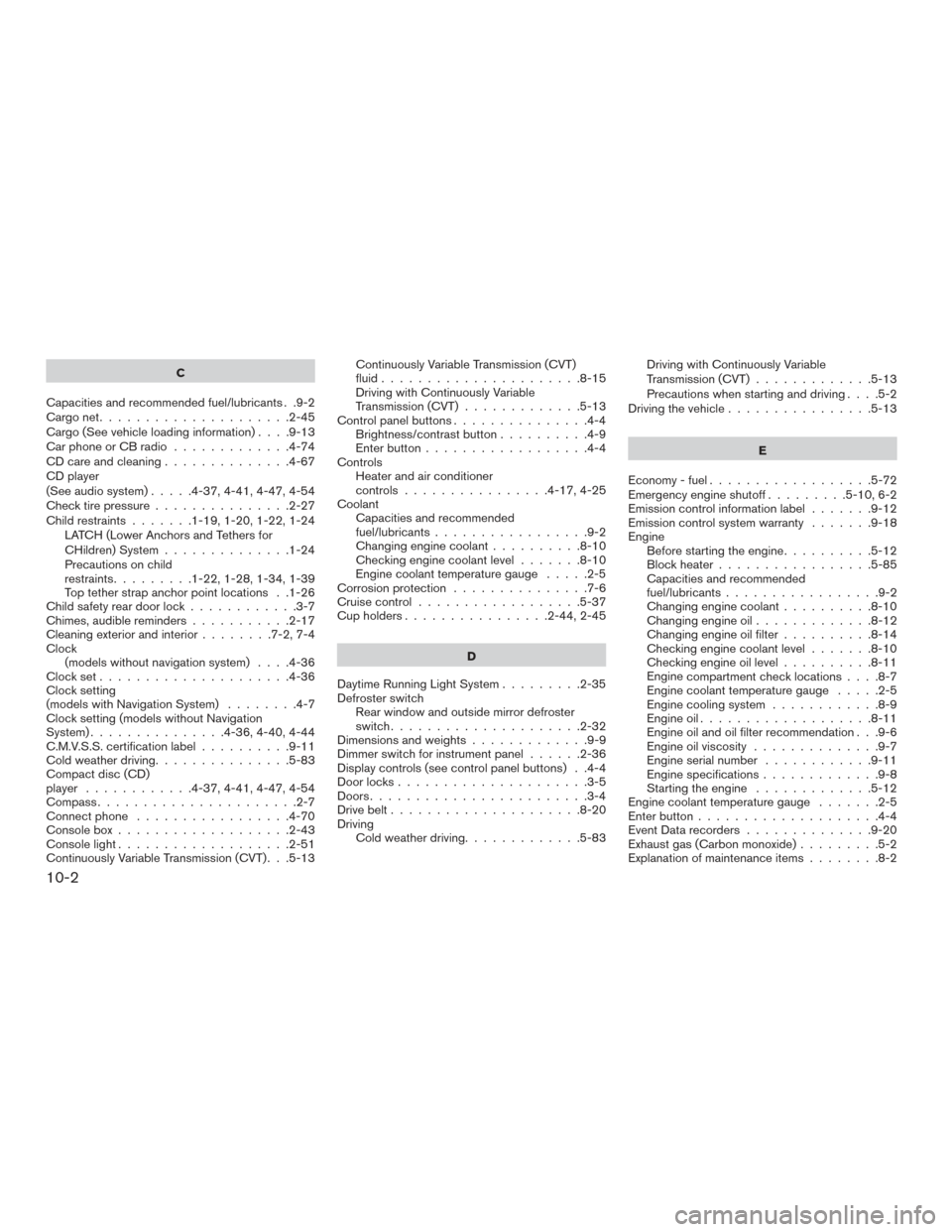
C
Capacities and recommended fuel/lubricants . .9-2
Cargonet.....................2-45
Cargo(Seevehicleloadinginformation)....9-13
Car phone or CB radio .............4-74
CD care and cleaning ..............4-67
CD player
(See audio system) .....4-37,4-41,4-47,4-54
Check tire pressure ...............2-27
Child restraints .......1-19,1-20,1-22,1-24
LATCH (Lower Anchors and Tethers for
CHildren) System ..............1-24
Precautions on child
restraints.........1-22,1-28,1-34,1-39
Top tether strap anchor point locations . .1-26
Child safety rear door lock ............3-7
Chimes, audible reminders ...........2-17
Cleaningexteriorandinterior........7-2,7-4
Clock (models without navigation system) ....4-36
Clockset.....................4-36
Clock setting
(models with Navigation System) ........4-7
Clock setting (models without Navigation
System) ...............4-36,4-40,4-44
C.M.V.S.S. certification label ..........9-11
Cold weather driving ...............5-83
Compact disc (CD)
player ............4-37,4-41,4-47,4-54
Compass ......................2-7
Connect phone .................4-70
Consolebox...................2-43
Consolelight...................2-51
Continuously Variable Transmission (CVT) . . .5-13 Continuously Variable Transmission (CVT)
fluid......................8-15
Driving with Continuously Variable
Transmission (CVT)
.............5-13
Control panel buttons ...............4-4
Brightness/contrast button ..........4-9
Enterbutton..................4-4
Controls Heater and air conditioner
controls................4-17,4-25
Coolant Capacities and recommended
fuel/lubricants .................9-2
Changingenginecoolant..........8-10
Checking engine coolant level .......8-10
Engine coolant temperature gauge .....2-5
Corrosion protection ...............7-6
Cruisecontrol..................5-37
Cupholders................2-44,2-45
D
Daytime Running Light System .........2-35
Defroster switch Rear window and outside mirror defroster
switch.....................2-32
Dimensionsandweights.............9-9
Dimmer switch for instrument panel ......2-36
Display controls (see control panel buttons) . .4-4
Door locks .....................3-5
Doors ........................3-4
Drive belt .....................8-20
Driving Cold weather driving .............5-83 Driving with Continuously Variable
Transmission (CVT)
.............5-13
Precautions when starting and driving ....5-2
Driving the vehicle ................5-13
E
Economy-fuel..................5-72
Emergency engine shutoff .........5-10,6-2
Emission control information label .......9-12
Emission control system warranty .......9-18
Engine Before starting the engine ..........5-12
Blockheater.................5-85
Capacities and recommended
fuel/lubricants.................9-2
Changing engine coolant ..........8-10
Changingengineoil.............8-12
Changing engine oil filter ..........8-14
Checking engine coolant level .......8-10
Checking engine oil level ..........8-11
Engine
compartment check locations ....8-7
Engine coolant temperature gauge .....2-5
Engine cooling system ............8-9
Engineoil...................8-11
Engine oil and oil filter recommendation . . .9-6
Engine oil viscosity ..............9-7
Engine serial number ............9-11
Engine specifications .............9-8
Starting the engine .............5-12
Engine coolant temperature gauge .......2-5
Enter button ....................4-4
Event Data recorders ..............9-20
Exhaust gas (Carbon monoxide) .........5-2
Explanation of maintenance items ........8-2
10-2
Page 470 of 491
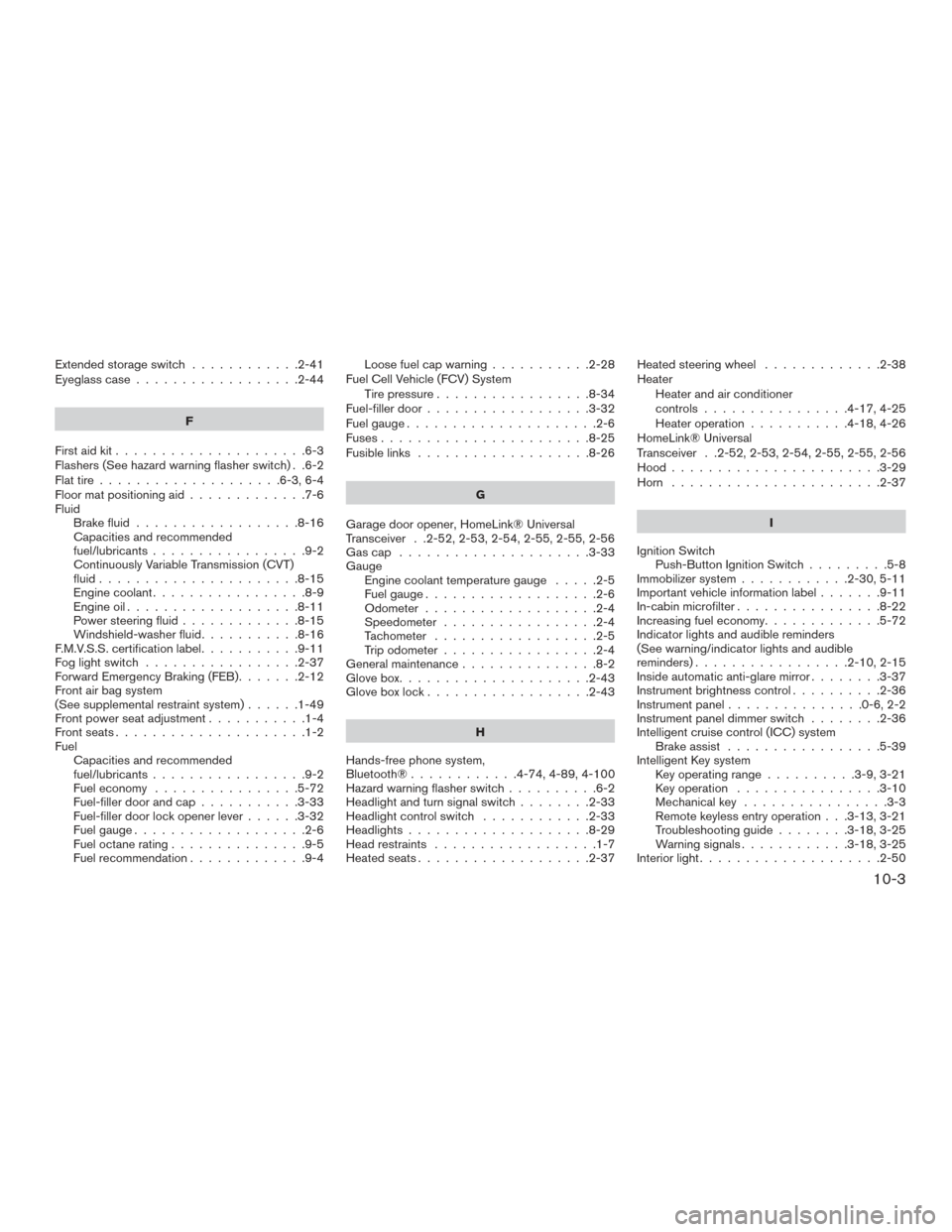
Extendedstorageswitch ............2-41
Eyeglass case..................2-44
F
First aid kit .....................6-3
Flashers (See hazard warning flasher switch) . .6-2
Flat tire ....................6-3,6-4
Floor mat positioning aid .............7-6
Fluid Brake fluid ..................8-16
Capacities and recommended
fuel/lubricants .................9-2
Continuously Variable Transmission (CVT)
fluid......................8-15
Engine coolant .................8-9
Engine oil ...................8-11
Power steering fluid .............8-15
Windshield-washerfluid...........8-16
F.M.V.S.S. certification label ...........9-11
Foglightswitch .................2-37
Forward Emergency Braking (FEB) .......2-12
Front air bag system
(See supplemental restraint system) ......1-49
Front power seat adjustment ...........1-4
Frontseats.....................1-2
Fuel Capacities and recommended
fuel/lubricants .................9-2
Fuel economy ................5-72
Fuel-filler door and cap ...........3-33
Fuel-filler door lock opener lever ......3-32
Fuel gauge ...................2-6
Fuel octane rating ...............9-5
Fuel recommendation .............9-4 Loose fuel cap warning
...........2-28
Fuel Cell Vehicle (FCV) System Tirepressure.................8-34
Fuel-filler door ..................3-32
Fuelgauge.....................2-6
Fuses.......................8-25
Fusiblelinks ...................8-26
G
Garage door opener, HomeLink® Universal
Transceiver . .2-52, 2-53, 2-54, 2-55, 2-55, 2-56
Gascap .....................3-33
Gauge Engine coolant temperature gauge .....2-5
Fuel gauge ...................2-6
Odometer ...................2-4
Speedometer .................2-4
Tachometer ..................2-5
Trip odometer .................2-4
General maintenance ...............8-2
Glovebox.....................2-43
Gloveboxlock..................2-43
H
Hands-free phone system,
Bluetooth®............4-74,4-89,4-100
Hazard warning flasher switch ..........6-2
Headlight and turn signal switch ........2-33
Headlight control switch ............2-33
Headlights ....................8-29
Head restraints ..................1-7
Heated seats ...................2-37 Heated steering wheel
.............2-38
Heater Heater and air conditioner
controls ................4-17,4-25
Heater operation ...........4-18,4-26
HomeLink® Universal
Transceiver . .2-52, 2-53, 2-54, 2-55, 2-55, 2-56
Hood.......................3-29
Horn .......................2-37
I
Ignition Switch Push-Button Ignition Switch .........5-8
Immobilizer system ............2-30,5-11
Important vehicle information label .......9-11
In-cabin microfilter ................8-22
Increasing
fuel economy .............5-72
Indicator lights and audible reminders
(See warning/indicator lights and audible
reminders).................2-10,2-15
Inside automatic anti-glare mirror ........3-37
Instrument brightness control ..........2-36
Instrumentpanel...............0-6,2-2
Instrument panel dimmer switch ........2-36
Intelligent cruise control (ICC) system Brake assist .................5-39
Intelligent Key system Key operating range ..........3-9,3-21
Key operation ................3-10
Mechanical key ................3-3
Remote keyless entry operation . . .3-13, 3-21
Troubleshooting guide ........3-18,3-25
Warning signals ............3-18,3-25
Interior light ....................2-50
10-3
Page 471 of 491
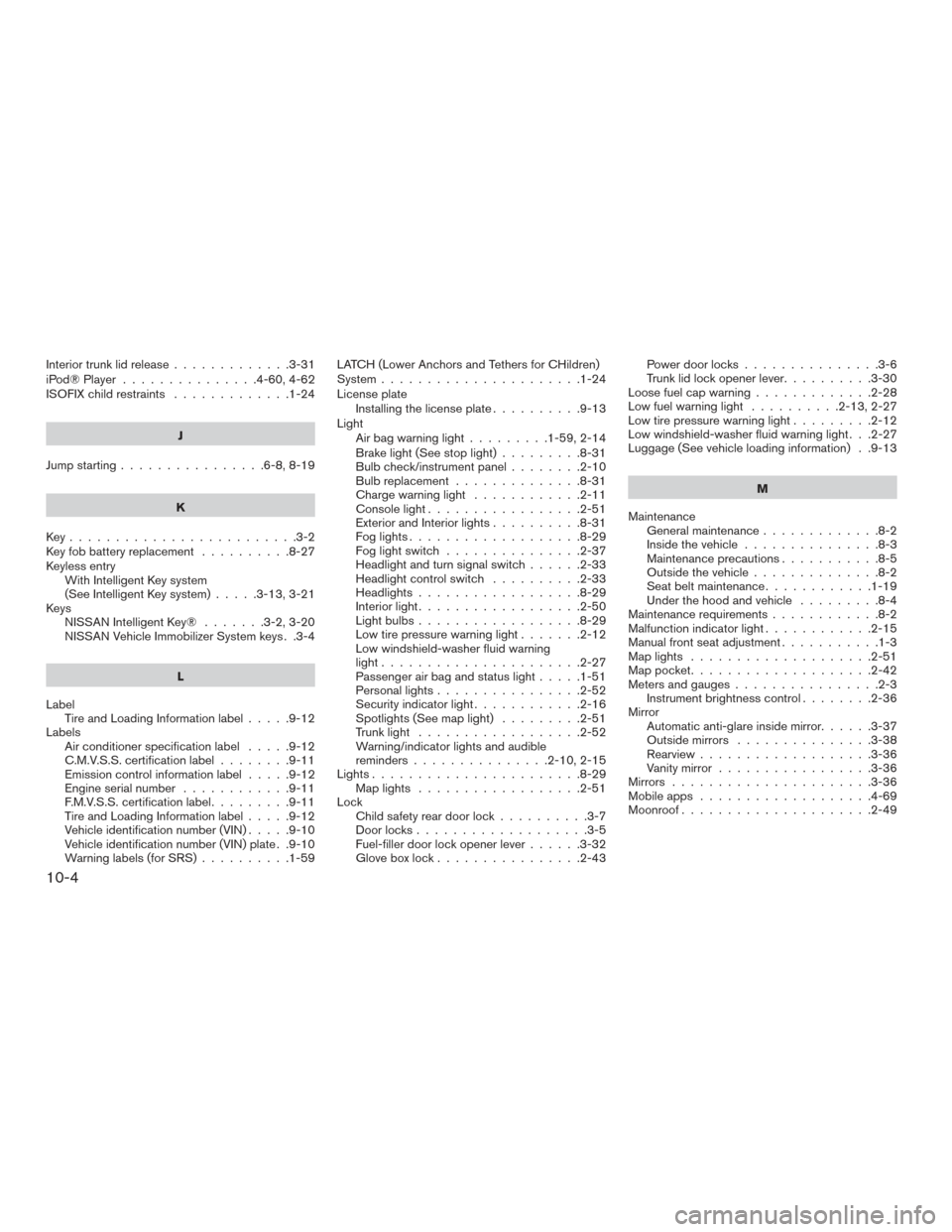
Interiortrunklidrelease.............3-31
iPod®Player ...............4-60,4-62
ISOFIX child restraints.............1-24
J
Jump starting ................6-8,8-19
K
Key.........................3-2
Key fob battery replacement ..........8-27
Keyless entry With Intelligent Key system
(See Intelligent Key system) .....3-13,3-21
Keys NISSAN Intelligent Key® .......3-2,3-20
NISSAN Vehicle Immobilizer System keys . .3-4
L
Label Tire and Loading Information label .....9-12
Labels Air conditioner specification label .....9-12
C.M.V.S.S. certification label ........9-11
Emissioncontrolinformationlabel.....9-12
Engine serial number ............9-11
F.M.V.S.S. certification label .........9-11
Tire and Loading Information label .....9-12
Vehicle identification number (VIN) .....9-10
Vehicle identification number (VIN) plate . .9-10
Warning labels (for SRS) ..........1-59LATCH (Lower Anchors and Tethers for CHildren)
System
......................1-24
License plate Installing the license plate ..........9-13
Light Air bag warning light .........1-59,2-14
Brake light (See stop light) .........8-31
Bulb check/instrument panel ........2-10
Bulbreplacement..............8-31
Charge warning light ............2-11
Consolelight.................2-51
Exterior and Interior lights ..........8-31
Foglights...................8-29
Foglightswitch ...............2-37
Headlight and turn signal switch ......2-33
Headlight control switch ..........2-33
Headlights..................8-29
Interiorlight..................2-50
Lightbulbs..................8-29
Low tire pressure warning light .......2-12
Low windshield-washer fluid warning
light......................2-27
Passenger air bag and status light .....1-51
Personal lights ................2-52
Security indicator light ............2-16
Spotlights(Seemaplight) .........2-51
Trunklight ..................2-52
Warning/indicator lights and audible
reminders ...............2-10,2-15
Lights.......................8-29 Maplights ..................2-51
Lock Child safety rear door lock ..........3-7
Door locks ...................3-5
Fuel-filler door lock opener lever ......3-32
Gloveboxlock................2-43 Power door locks
...............3-6
Trunk lid lock opener lever ..........3-30
Loose fuel cap warning .............2-28
Low fuel warning light ..........2-13,2-27
Low tire pressure warning light .........2-12
Low windshield-washer fluid warning light . . .2-27
Luggage (See vehicle loading information) . .9-13
M
Maintenance General maintenance .............8-2
Insidethevehicle...............8-3
Maintenance precautions ...........8-5
Outside the vehicle ..............8-2
Seat belt maintenance ............1-19
Under the hood and vehicle .........8-4
Maintenance requirements ............
8-2
Malfunction indicator light ............2-15
Manual front seat adjustment ...........1-3
Maplights ....................2-51
Mappocket....................2-42
Meters and gauges ................2-3
Instrument brightness control ........2-36
Mirror Automatic anti-glare inside mirror ......3-37
Outside mirrors ...............3-38
Rearview ...................3-36
Vanity mirror .................3-36
Mirrors ......................3-36
Mobileapps ...................4-69
Moonroof .....................2-49
10-4
Page 478 of 491
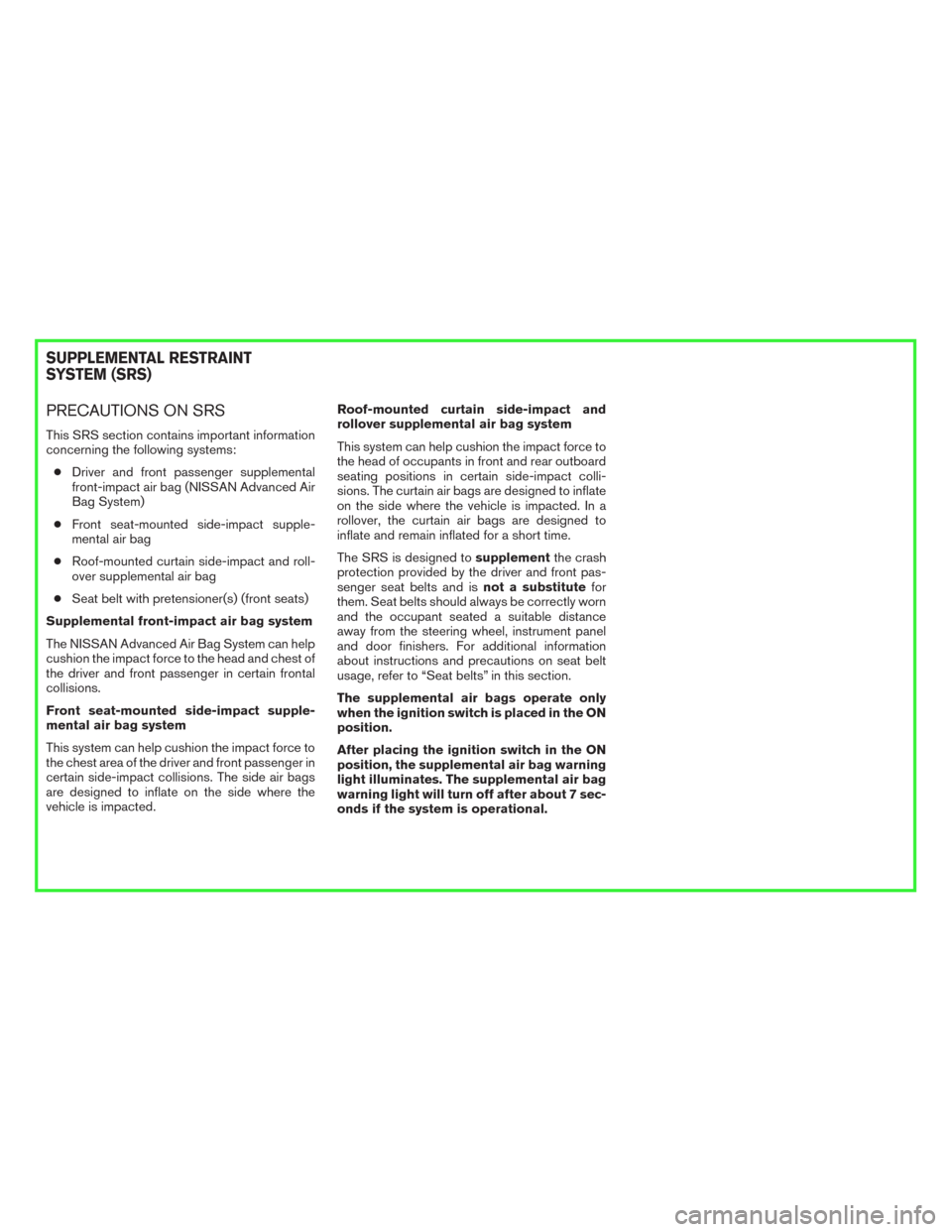
PRECAUTIONS ON SRS
This SRS section contains important information
concerning the following systems:
●Driver and front passenger supplemental
front-impact air bag (NISSAN Advanced Air
Bag System)
●Front seat-mounted side-impact supple-
mental air bag
●Roof-mounted curtain side-impact and roll-
over supplemental air bag
●Seat belt with pretensioner(s) (front seats)
Supplemental front-impact air bag system
The NISSAN Advanced Air Bag System can help
cushion the impact force to the head and chest of
the driver and front passenger in certain frontal
collisions.
Front seat-mounted side-impact supple-
mental air bag system
This system can help cushion the impact force to
the chest area of the driver and front passenger in
certain side-impact collisions. The side air bags
are designed to inflate on the side where the
vehicle is impacted.Roof-mounted curtain side-impact and
rollover supplemental air bag system
This system can help cushion the impact force to
the head of occupants in front and rear outboard
seating positions in certain side-impact colli-
sions. The curtain air bags are designed to inflate
on the side where the vehicle is impacted. In a
rollover, the curtain air bags are designed to
inflate and remain inflated for a short time.
The SRS is designed tosupplementthe crash
protection provided by the driver and front pas-
senger seat belts and isnot a substitutefor
them. Seat belts should always be correctly worn
and the occupant seated a suitable distance
away from the steering wheel, instrument panel
and door finishers. For additional information
about instructions and precautions on seat belt
usage, refer to “Seat belts” in this section.
The supplemental air bags operate only
when the ignition switch is placed in the ON
position.
After placing the ignition switch in the ON
position, the supplemental air bag warning
light illuminates. The supplemental air bag
warning light will turn off after about 7 sec-
onds if the system is operational.
SUPPLEMENTAL RESTRAINT
SYSTEM (SRS)
Page 484 of 491
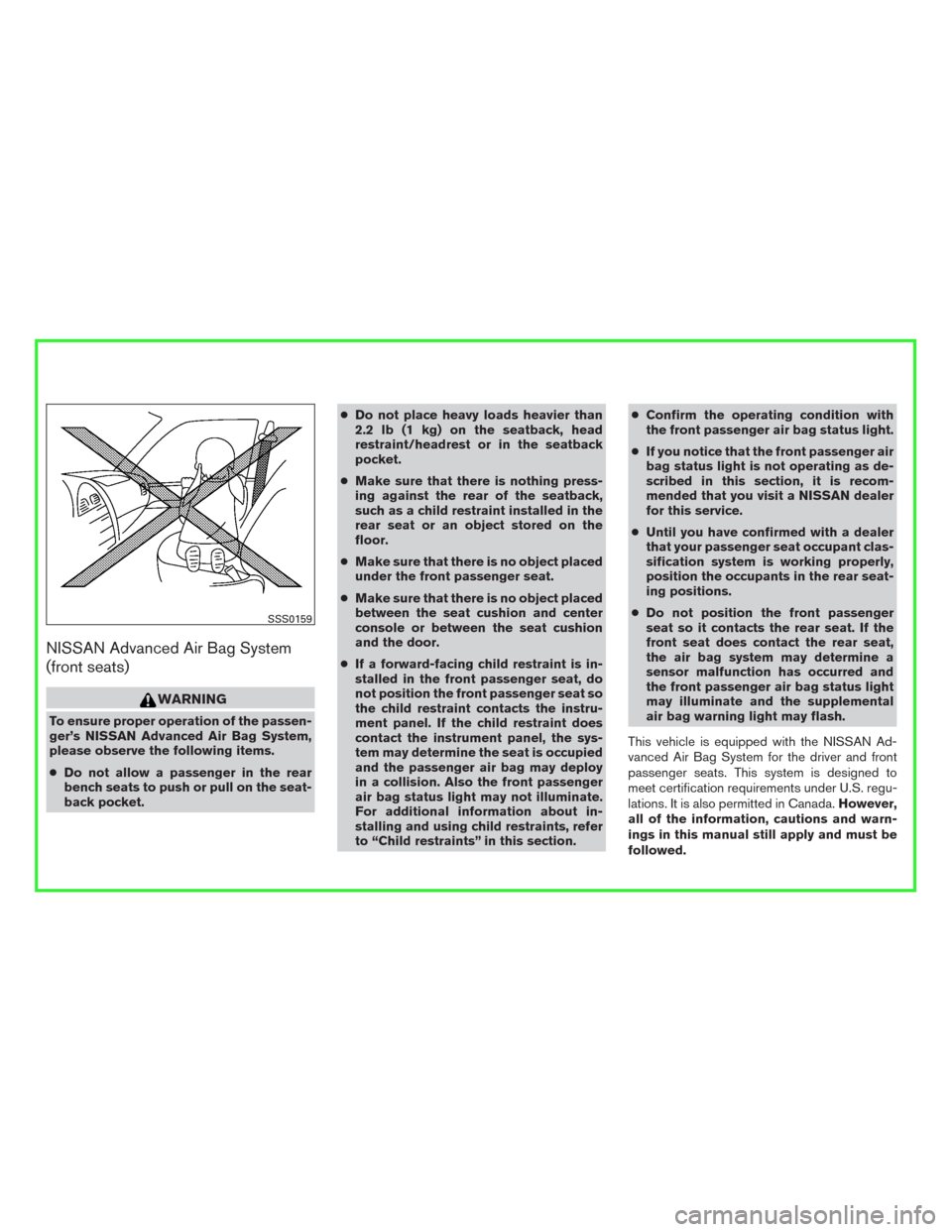
NISSAN Advanced Air Bag System
(front seats)
WARNING
To ensure proper operation of the passen-
ger’s NISSAN Advanced Air Bag System,
please observe the following items.
●Do not allow a passenger in the rear
bench seats to push or pull on the seat-
back pocket.●Do not place heavy loads heavier than
2.2 lb (1 kg) on the seatback, head
restraint/headrest or in the seatback
pocket.
●Make sure that there is nothing press-
ing against the rear of the seatback,
such as a child restraint installed in the
rear seat or an object stored on the
floor.
●Make sure that there is no object placed
under the front passenger seat.
●Make sure that there is no object placed
between the seat cushion and center
console or between the seat cushion
and the door.
●If a forward-facing child restraint is in-
stalled in the front passenger seat, do
not position the front passenger seat so
the child restraint contacts the instru-
ment panel. If the child restraint does
contact the instrument panel, the sys-
tem may determine the seat is occupied
and the passenger air bag may deploy
in a collision. Also the front passenger
air bag status light may not illuminate.
For additional information about in-
stalling and using child restraints, refer
to “Child restraints” in this section.●Confirm the operating condition with
the front passenger air bag status light.
●If you notice that the front passenger air
bag status light is not operating as de-
scribed in this section, it is recom-
mended that you visit a NISSAN dealer
for this service.
●Until you have confirmed with a dealer
that your passenger seat occupant clas-
sification system is working properly,
position the occupants in the rear seat-
ing positions.
●Do not position the front passenger
seat so it contacts the rear seat. If the
front seat does contact the rear seat,
the air bag system may determine a
sensor malfunction has occurred and
the front passenger air bag status light
may illuminate and the supplemental
air bag warning light may flash.
This vehicle is equipped with the NISSAN Ad-
vanced Air Bag System for the driver and front
passenger seats. This system is designed to
meet certification requirements under U.S. regu-
lations. It is also permitted in Canada.However,
all of the information, cautions and warn-
ings in this manual still apply and must be
followed.
SSS0159